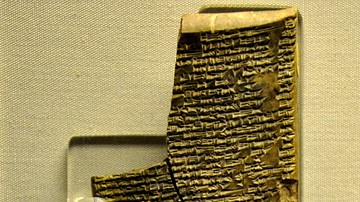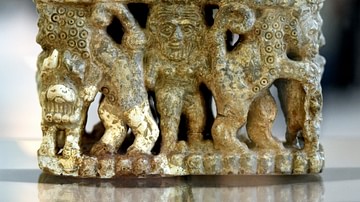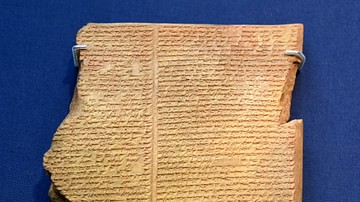Review

| Rating: | |
|---|---|
| Title: | Exploring the Life, Myth, and Art of the Ancient Near East (Civilizations of the World) |
| Author: | Michael Kerrigan & Alan Lothian |
| Audience: | High School |
| Difficulty: | Easy |
| Publisher: | Rosen Young Adult |
| Published: | 2016 |
| Pages: | 145 |
In Exploring the Life, Myth, and Art of the Ancient Near East, Michael Kerrigan attempts to present the cultural depth of the ancient Near East through its myths and art, writing primarily for grades 7-12. I highly recommend that libraries and parents do not purchase this volume for students. Besides the fact that the 1998 edition (First Edition) is cheaper, other resources exist which are substantially more helpful for introducing students to ancient Near Eastern myths.
In Exploring the Life, Myth, and Art of the Ancient Near East, Michael Kerrigan attempts to present the cultural depth of the ancient Near East through its myths and art, writing primarily for grades 7-12. He does so by offering summaries from Assyrian, Babylonian/Sumerian, Hittite, and Ugaritic myth literature, each page containing at least one image of art concerning the story or the region being discussed. Likewise, he attempts to place these myths within their respective historical context, namely how they relate to other material and various empires. This book was originally published in 1998 as Epics of Early Civilization: Myths of the Ancient Near East (Duncan Baird Publishers, 1998).
Oddly enough, there is not much available concerning the background and training of the author and the two co-authors. They were involved in writing Ancient India's Myths and Beliefs, Ancient Egypt's Myths and Beliefs, and Native American Myths and Beliefs (Rosen Publishing, 2012), but I could not find credentials for any of the authors, which raises a red flag concerning the information presented in this book.
Unfortunately, the book is splattered with a variety of problems which makes the quality of the volume highly questionable. First of all, the format and layout of the book are unclear. The content is divided into six sections: 'The Ancient Near East' (general overview), 'A Divine Realm', 'A Land of Champions', 'The Kingdom of Baal' (Ugarit), 'The Hittites' (Anatolia), and 'The Legacy of the Mesopotamians' (Legacy), and although I suggest what each section is about, this was not clear until I flipped through the book several times, trying to make sense of the ambiguous categories. Even so, it is still unclear what 'A Divine Realm' and 'A Land of Champions' refer to.
The problem extends beyond the titles. Within the sections, there are subheadings which have no logical connection to the preceding or the proceeding page. The book seems to be a collection of random, short summaries and images of myths with no continuity or obvious organization of the content. Additionally, the formatting of the pages is confusing. In many cases, stories are split by random entries on something completely different with no formatting indicating an excursus. Ultimately, this is one of the biggest flaws of the book: it looks entirely unprofessional, which makes the stories themselves difficult to read and follow.
Second, the authors are entirely unfamiliar with any strides made within biblical scholarship. The author uses highly problematic terms, anachronistic and ideologically charged language. Moreover, some of the implications are misleading, especially to grade-school students who do not have the experience or knowledge to realize the problems with the presentation. Biblical and Near Eastern scholarship can be confusing and oftentimes overwhelming. Its blatant disregard, though, along with simple acceptance of biblical narratives as historically accurate, causes me to question the validity of any historical claims made by the authors.
Third, there is the scant, problematic section for further reading, which includes Persian poetry written in the 10th century CE, not exactly “ancient” Near East. Concerning primary texts, it would be cheaper and easier for libraries to point students towards online resources. They suggest this in the book, however, the link included does not lead to anything. Concerning a bibliography, there is absolutely none.
In light of the above, I highly recommend that libraries and parents do not purchase this volume for students. Besides the fact that the 1998 edition (First Edition) is cheaper, other resources exist which are substantially more helpful for introducing students to ancient Near Eastern myths. More productive, inexpensive alternatives could include the following material: “Gilgamesh” by Joshua J. Mark; primary source material and articles at Livius; the ETANA database; “The Melammu Project” or the ORACC database, with the accompanying introductory material.
About the Reviewer
Cite This Work
APA Style
Brown, W. (2018, September 20). Exploring the Life, Myth, and Art of the Ancient Near East. World History Encyclopedia. Retrieved from https://www.worldhistory.org/review/194/exploring-the-life-myth-and-art-of-the-ancient-nea/
Chicago Style
Brown, William. "Exploring the Life, Myth, and Art of the Ancient Near East." World History Encyclopedia. Last modified September 20, 2018. https://www.worldhistory.org/review/194/exploring-the-life-myth-and-art-of-the-ancient-nea/.
MLA Style
Brown, William. "Exploring the Life, Myth, and Art of the Ancient Near East." World History Encyclopedia. World History Encyclopedia, 20 Sep 2018. Web. 19 Apr 2024.



